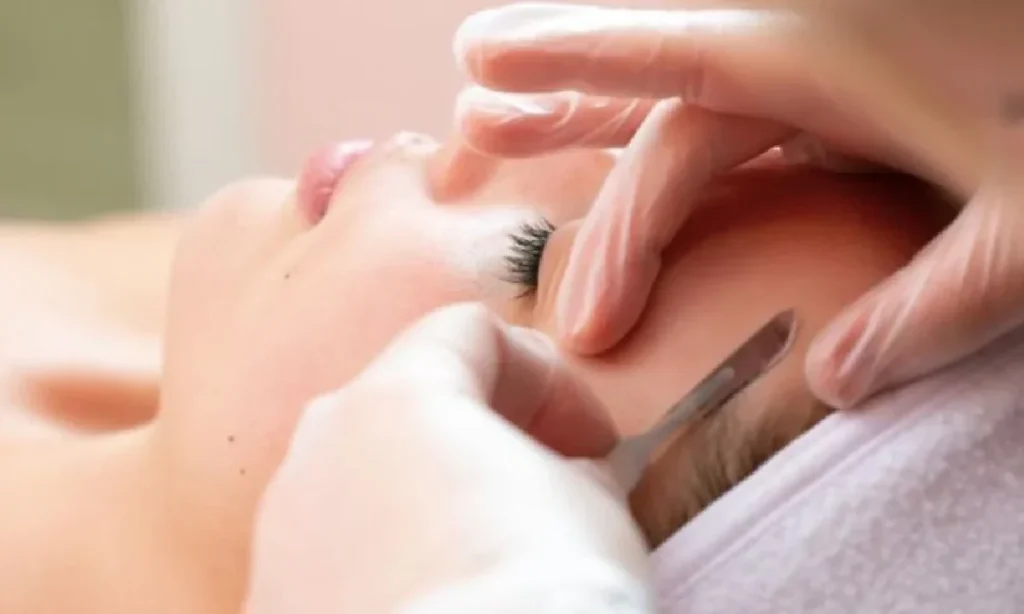Table of Contents
Introduction to Dermaplaning
What is Dermaplaning?
Dermaplaning, a popular cosmetic procedure, delicately removes the surface layer of dulling dead skin cells and vellus hair (commonly known as peach fuzz) from the face. This meticulous exfoliation technique provides more than just a physical transformation; it unveils a skin texture that is not only smoother but also notably brighter. By eliminating the accumulated dead skin cells, dermaplaning opens the gateway to a rejuvenated complexion, reflecting light more evenly and contributing to a radiant appearance.
The allure of dermaplaning extends beyond skin aesthetics. Beyond fostering a flawless canvas for makeup application, this procedure enhances the efficacy of skincare products. With the barrier of dead skin cells removed, topical treatments can penetrate the skin more effectively, maximizing their impact. The result is not only a cosmetic enhancement but also a practical elevation of skincare routine outcomes, making dermaplaning an appealing choice for those seeking both immediate visual improvements and long-term skin health benefits.
Dermaplaning, as a cosmetic procedure, goes beyond the surface to provide a holistic rejuvenation for the skin. The meticulous removal of vellus hair, or peach fuzz, not only contributes to a smoother texture but also addresses the common concern of unwanted facial hair. The absence of fine hairs allows for a more even distribution of makeup, preventing it from catching on hair strands and ensuring a seamless application. This characteristic makes dermaplaning particularly favored by those aiming for a flawless makeup finish, whether for special occasions or everyday confidence. Additionally, the exfoliation achieved through dermaplaning promotes cellular turnover, aiding in the reduction of uneven skin tone and the appearance of fine lines, revealing a more youthful complexion.
Beyond its visible impact, dermaplaning enhances the skin’s receptivity to skincare products. By eliminating the layer of dead skin cells that often acts as a barrier, dermaplaning creates an optimal environment for the absorption of serums, moisturizers, and other topical treatments. This increased absorption can boost the effectiveness of skincare products, leading to more pronounced and long-lasting results. As a result, dermaplaning becomes not only a cosmetic indulgence but also a strategic component in one’s skincare regimen, offering a dual benefit of immediate aesthetic enhancement and improved product efficacy. Whether seeking a radiant complexion for a special occasion or aiming to elevate the effectiveness of daily skincare routines, dermaplaning stands out as a versatile and effective solution.
Brief History and Evolution
Dermaplaning traces its roots to ancient practices of manual exfoliation, where cultures across the globe utilized various tools to remove dead skin and fine facial hair. While the exact historical origins are challenging to pinpoint, the concept of improving skin texture through gentle scraping has persisted for generations. In more recent history, dermaplaning gained prominence as a common practice in dermatology and cosmetic surgery. Its initial applications were primarily medical, focused on preparing the skin for surgical procedures or addressing certain skin irregularities.
Over the years, the evolution of dermaplaning has been marked by a fusion of traditional techniques with modern innovations. Early practitioners used basic tools, often non-sterile blades, to manually scrape the skin’s surface. However, as dermatology and skincare advanced, the procedure underwent significant refinement. Sterilization protocols became more stringent, and the tools evolved to include specialized surgical scalpels designed for precise and controlled exfoliation. This transformation elevated dermaplaning from a rudimentary process to a sophisticated, well-established facial treatment known for its precision and safety.
In recent decades, the widespread popularity of dermaplaning can be attributed to its incorporation into mainstream beauty salons and medical spas. Technological advancements, such as the development of high-quality blades and the introduction of safety measures, have contributed to its widespread acceptance. The procedure has become not only more effective but also safer, with professionals adhering to strict hygiene standards. Moreover, the appeal of dermaplaning extends beyond its initial medical applications, as it has found a niche in the beauty industry for those seeking a non-invasive yet transformative solution for achieving a luminous and smooth complexion. Today, dermaplaning stands as a testament to the dynamic interplay between historical practices and modern innovations in the pursuit of radiant and healthy skin.
The Benefits of Dermaplaning
Enhanced Skin Texture
One of the most immediate and gratifying benefits of dermaplaning is the noticeable improvement in skin texture. This simple yet effective procedure scrapes away the outermost layer of dead skin cells that often contribute to a dull, uneven complexion. The result? Skin that is incredibly soft and smooth. Imagine a canvas that’s been primed and smoothed out, ready for a beautiful painting. That’s what dermaplaning does for your skin. It leaves it feeling rejuvenated, revitalized, and ready to radiate its natural glow. This improvement in texture is not just superficial; it reflects a deeper, healthier state of the skin where cells are regenerated more effectively, giving you that sought-after fresh and vibrant look.
Improved Absorption of Skin Care Products
Another significant benefit of dermaplaning lies in its ability to enhance the efficacy of your skincare regimen. By removing the outermost layer of dead skin, dermaplaning acts as a catalyst for the deeper penetration of skincare products. Think of it as clearing a blocked path so that nourishing ingredients can travel deeper into the skin. This increased absorption means that serums, moisturizers, and other skincare essentials can perform at their highest potential. Active ingredients in your skincare products are no longer just sitting on the surface; they are actually being absorbed where they can work more effectively, thereby amplifying their benefits. This can lead to noticeable improvements in skin hydration, texture, and overall health.

Reduction in Fine Lines and Wrinkles
Regular dermaplaning sessions offer more than just immediate aesthetic benefits; they contribute to the long-term health and youthfulness of your skin. One of the most appreciated long-term effects is the reduction in the appearance of fine lines and wrinkles. As dermaplaning removes dead skin cells and stimulates the surface of the skin, it can encourage the natural cell regeneration process, promoting the production of new, healthy skin cells.
Over time, this can result in a visible reduction of fine lines and wrinkles, giving your skin a smoother, more youthful appearance. This aspect of dermaplaning is particularly beneficial for those who are looking for non-invasive ways to maintain a youthful complexion without resorting to more drastic cosmetic procedures. Regular maintenance not only helps in diminishing existing lines but also in preventing new ones from forming, thus contributing to a more age-defying look.
In summary, dermaplaning is more than just a quick fix for a radiant face; it’s a comprehensive approach to maintaining healthy, youthful skin. Its benefits, ranging from enhanced texture and improved product absorption to the reduction of fine lines, make it an essential component of a holistic skincare routine.
Step-by-Step Guide to Dermaplaning
Step 1: Preparing Your Skin
The first step in the dermaplaning process is all about creating the perfect base for the procedure. Begin by thoroughly cleansing your skin to remove any traces of makeup, oil, and dirt. This is crucial for ensuring that the dermaplaning process is both smooth and effective. A clean face is essential to prevent any bacteria from being spread across your skin during dermaplaning. Use a gentle, non-abrasive cleanser that suits your skin type to avoid any pre-procedure irritation. After cleansing, pat your skin dry with a soft towel. It’s important that your skin is completely dry because moisture can cause the blade to slip, leading to uneven results or nicks.
Step 2: Choosing the Right Tools
The tools you use for dermaplaning make a significant difference in the effectiveness and safety of the procedure. Select a professional-grade dermaplaning tool or a single-blade safety razor specifically designed for this purpose. The blade should be sharp, as a dull blade can pull at the skin and cause irritation or injury. It’s also crucial to ensure the blade is clean to prevent any risk of infection. Some prefer using disposable blades for each session to maintain the highest level of hygiene. When choosing your tool, consider the handle’s ergonomics – it should be comfortable to hold and offer precise control.
Step 3: The Dermaplaning Process
Now, you’re ready for the actual dermaplaning process. Start by gently pulling your skin taut with one hand. This will create a flat and stable surface for the blade to glide over. With your other hand, hold the blade at a 45-degree angle to your skin. This angle is optimal for effectively removing dead skin cells and peach fuzz without causing irritation. Begin with short, feathery strokes, moving the blade in the direction of hair growth. Take extra care around sensitive areas such as the lips, nose, and near the hairline. It’s essential to apply only light pressure; the weight of the blade is often enough. Go slowly and methodically to ensure you don’t miss any spots.
Step 4: Post-Dermaplaning Care
After dermaplaning, your skin will be more sensitive and vulnerable, so post-care is vital. Immediately soothe your skin with a hydrating serum or moisturizer to calm any redness or irritation. Opt for products that are free from harsh chemicals and fragrances to avoid any adverse reactions. For the next few days, avoid using exfoliating products, including those with AHAs, BHAs, or physical scrubs, as they can irritate freshly dermaplaned skin. Also, be mindful of sun exposure. Since the protective layer of dead skin has been removed, your skin is more susceptible to UV damage, so apply a broad-spectrum sunscreen with an SPF of 30 or higher.
Step 5: Maintenance and Frequency
For optimal results and to maintain the benefits of dermaplaning, it’s recommended to repeat the process once every three to four weeks. This timeline aligns with the skin’s natural rejuvenation cycle, allowing enough time for the skin to heal and new cellular growth to occur. Consistent maintenance not only helps in sustaining the immediate effects of dermaplaning, such as smoothness and radiance, but also contributes to long-term skin health. However, it’s important to listen to your skin – if you experience any prolonged irritation or sensitivity, it may be wise to extend the time between sessions.
In conclusion, following these steps will help ensure your dermaplaning experience is both effective and safe, leading to a radiant, smooth, and rejuvenated complexion.
Common Misconceptions and Myths
Myth 1: Dermaplaning Causes Hair to Grow Back Thicker
Contrary to popular belief, dermaplaning does not affect the texture or growth rate of your facial hair.
Myth 2: Dermaplaning is Painful
Dermaplaning is a non-invasive, pain-free procedure when done correctly.
Myth 3: Dermaplaning is Only for Women
This skincare treatment is beneficial for anyone looking to improve their skin’s appearance, regardless of gender.
Professional vs. At-Home Dermaplaning
The Pros and Cons
Professional dermaplaning is performed by trained aestheticians and tends to be more thorough, whereas at-home dermaplaning offers convenience and cost-effectiveness.
Safety Considerations
Always prioritize safety, whether at home or in a professional setting. Ensure the tools are sterile and be cautious during the procedure.
Skin Types and Dermaplaning
Suitable Skin Types
Dermaplaning is suitable for most skin types, particularly those with dry or dull skin. It can also benefit those with fine wrinkles and mild acne scarring.
Precautions for Sensitive Skin
If you have sensitive skin, conduct a patch test or consult a professional before proceeding with dermaplaning.
Combining Dermaplaning with Other Treatments
Synergistic Treatments: Enhancing Dermaplaning Results
The versatility of dermaplaning lies in its compatibility with various skincare treatments, allowing individuals to customize their skincare regimen for optimal results. When combined with chemical peels or hydrating facials, dermaplaning creates a synergistic effect. Chemical peels, which involve the application of acid solutions to exfoliate the skin, can penetrate more effectively after dermaplaning, leading to a deeper and more even exfoliation. This tandem approach is particularly effective in addressing concerns such as uneven skin tone, fine lines, and texture irregularities. On the other hand, pairing dermaplaning with hydrating facials amplifies the skin’s moisture absorption, leaving it not only smooth but also deeply nourished.
What to Avoid: Cautionary Measures for Dermaplaning Combinations
While dermaplaning harmonizes well with certain treatments, caution is advised when considering aggressive exfoliating procedures in conjunction with dermaplaning. Combining dermaplaning with treatments that involve harsh abrasives or strong exfoliants can potentially lead to skin irritation and damage. It’s crucial to consult with a skincare professional who can assess individual skin needs and recommend a tailored treatment plan to avoid overloading the skin with excessive exfoliation.
Tips and Tricks for Optimal Results: Dos and Don’ts
- Do: Use Gentle Strokes
- During dermaplaning, gentle strokes are key. The objective is to delicately remove the outermost layer of dead skin and fine hairs without causing irritation or damage. The use of controlled, light strokes ensures a safe and effective exfoliation process.
- Don’t: Over-Exfoliate the Skin
- Over-exfoliation can compromise the skin barrier, leading to sensitivity and increased vulnerability. It’s essential to strike a balance and avoid excessive dermaplaning sessions or combining the procedure with aggressive exfoliants.
- Do: Keep the Skin Hydrated Post-Treatment
- After dermaplaning, maintaining proper hydration is crucial. Hydrated skin not only aids in the healing process but also enhances the overall luminosity and suppleness of the complexion. Applying a soothing, hydrating mask or moisturizer can contribute to post-treatment comfort.
- Don’t: Dermaplane Over Acne or Irritated Skin
- Dermaplaning should be avoided over active acne or irritated skin. This precaution prevents potential aggravation of existing conditions and ensures a smoother healing process. A skincare professional can guide individuals on the best course of action based on their specific skin concerns.
Expert Advice: Seeking Professional Guidance
Expert advice is paramount when considering dermaplaning in combination with other treatments. A skincare professional can assess individual skin conditions, recommend suitable combinations, and provide personalized care. Their expertise ensures a tailored approach that maximizes the benefits of dermaplaning while avoiding potential pitfalls. Consulting with a skincare expert ensures a comprehensive understanding of one’s unique skin needs and facilitates a safe and effective skincare journey.
FAQs About Dermaplaning
Q1: How Often Should You Dermaplane?
A: Ideally, once every three to four weeks to align with the skin’s natural rejuvenation cycle.
Q2: Can Dermaplaning Cause Acne?
A: No, it doesn’t cause acne. In fact, it can help in reducing acne scars over time.
Q3: Is Dermaplaning Suitable for All Ages?
A: Yes, it is suitable for adults of all ages, though the needs and results may vary based on individual skin types and conditions.
Conclusion
In conclusion, dermaplaning is a versatile and beneficial skin care treatment that can revolutionize your skincare routine. Whether you choose to do it at home or opt for a professional service, remember to follow the essential steps and tips to ensure safety and effectiveness. Give dermaplaning a try and embrace a brighter, smoother, and more youthful complexion.


